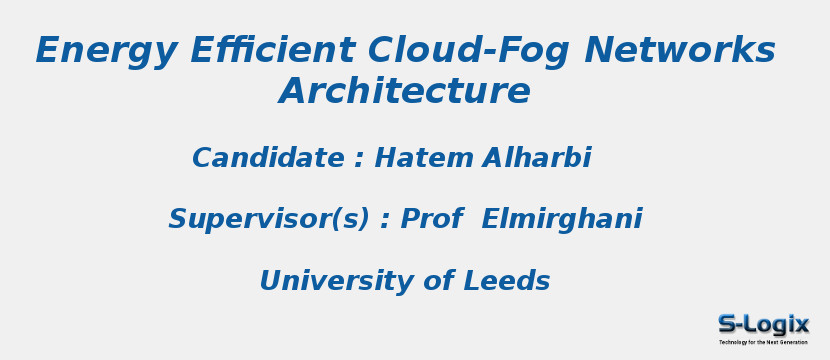Research Area: Fog Computing
The advancements of cloud computing came as a radical transformation in the way Information and Communication Technology (ICT) services are deployed, maintained and paid for. Cloud computing provides ubiquitous on-demand access to an Internet-based pool of processing, storage, and communication resources offered to a large set of geographically distributed users. As the cloud computing infrastructure grows and demand increases, the need for a new breed of on-demand computing that can efficiently and profitably maintain Quality of Service (QoS) requirements has increased. Fog computing was proposed to address the limitations of cloud computing in terms of delay and high bandwidth requirements by extending the on-demand resources of clouds to the edge of the network bringing them closer to the users. Cloud computing and fog computing employ Virtual Machines (VMs) for efficient resource utilization. To achieve the most of the efficient environment, VMs can be optimally placed over geo-distributed physical machines to follow variations in the demand, workload of the cloud/fog resources or network condition. The massive growth and wide use of cloud-fog services have created serious power consumption concerns.
In this thesis, we study the energy efficiency and profitability of cloud-fog architectures taking into consideration different services and applications. Mixed integer linear programming (MILP) optimisation models and heuristic algorithms are developed to optimise the cloud-fog architecture. The thesis starts by analysing the energy efficiency of VMs placement over distributed clouds. The analysis addresses the impact of different factors including VM popularity, the traffic between the VM and its users, the VM workload, the workload versus number of users profile and power usage effectiveness (PUEs). The total power savings achieved are up to 51% and 38%, compared to the power consumption of the traditional cloud locations in AT&T and BT core network topologies, respectively. Furthermore, the impact of inter-VM traffic (synchronisation and cooperation between VMs) on the energy efficiency is investigated in the context of optimal VM placement. The existence of inter-VM traffic has resulted on reducing the energy efficiency of replicating VMs. Our results showed that ignoring inter-VM traffic when placing VMs can increase the total power consumption by a factor of 39 for VMs with an inter-VM traffic data rate of 5 Gbps.
Then, the thesis shows how introducing fog layers at the edge of the network in addition to the cloud layer in the core network can significantly decrease the total power consumption of VMs of certain popularity, download rates and workloads. In addition, a pricing scheme is proposed for Internet service providers (ISPs) to maximise their profit under net neutrality repeal scenarios where ISPs are allowed to treat different traffic strands differently. The results shows that the VMs of a linear workload profile with high data rate and minimum CPU utilisation of 1% allows offloading VMs with 16% popularity to the access fogs. Other VMs are optimally replicated to metro fog nodes. Significant power savings of 48% compared to optimised placement in distributed clouds and 64% compared to a placement considering traditional cloud locations, have resulted from this offloading. A techno-economic MILP model is used to find the optimum prices of different levels of service and the resulting power consumption.
The proposed pricing scheme proves that, in addition to increasing ISPs profit, the repeal of net neutrality will positively influence (limit) the end-users’ consumption of data-intensive content which consequently decreases the power consumption of the communication networks. The results show that the discriminatory pricing scheme can increase the ISPs profit by a factor of 8. The results also show that by influencing the way end-users consume data-intensive content, the core network traffic and consequently power consumption are reduced by up to 49% and 55%, respectively, compared to the net neutrality scenario.
Name of the Researcher: Hatem Alharbi
Name of the Supervisor(s): Elmirghani
Year of Completion: 2020
University: University of Leeds
Thesis Link: Home Page Url
